Analyzing Long-Term High-Rise Building Areas Changes Using Deep Learning and Multisource Satellite Images
Abstract
1. Introduction
- We prove the effectiveness of Landsat-7 images in the extraction of HRBs using the FCN-based method. Additionally, we validate that our procedure can efficiently extract HRBs and their changes in the last 20 years in 4 typical cities using Landsat-7 and Sentinel-2 images. The results indicate that our procedure has the potential to be an operational tool to extract long-term and large-scale HRBs and their changes in China.
- We find that HRBs changes are primarily driven by urban planning policies and geographical factors. There is a strong positive correlation between the increase in HRBs and the increase in rail terminals, both in terms of quantity and spatial distribution. Additionally, there is a positive correlation between HRBs increase and GDP increase in terms of quantity, but the trend varies in different cities due to their diverse developing mode. These findings may pave the way for the wide use of HRBs in related studies.
2. Materials and Methods
2.1. Study Areas and Data
2.2. Methods
2.2.1. General Workflow
2.2.2. Fully Convolutional Network for HRBs Extraction
2.2.3. Accuracy Assessment Method
3. Results
3.1. The Results of HRBs Extraction in Each Period
3.2. The Results of HRBs Change Extraction
4. Discussion
4.1. Patterns of HRBs Changes in Terms of Quantity and Spatial Distribution
4.2. Correlation between HRBs Changes and Rail Terminal Changes
4.3. Correlation between HRBs Changes and Urban GDP Changes
5. Conclusions
Author Contributions
Funding
Data Availability Statement
Conflicts of Interest
Appendix A

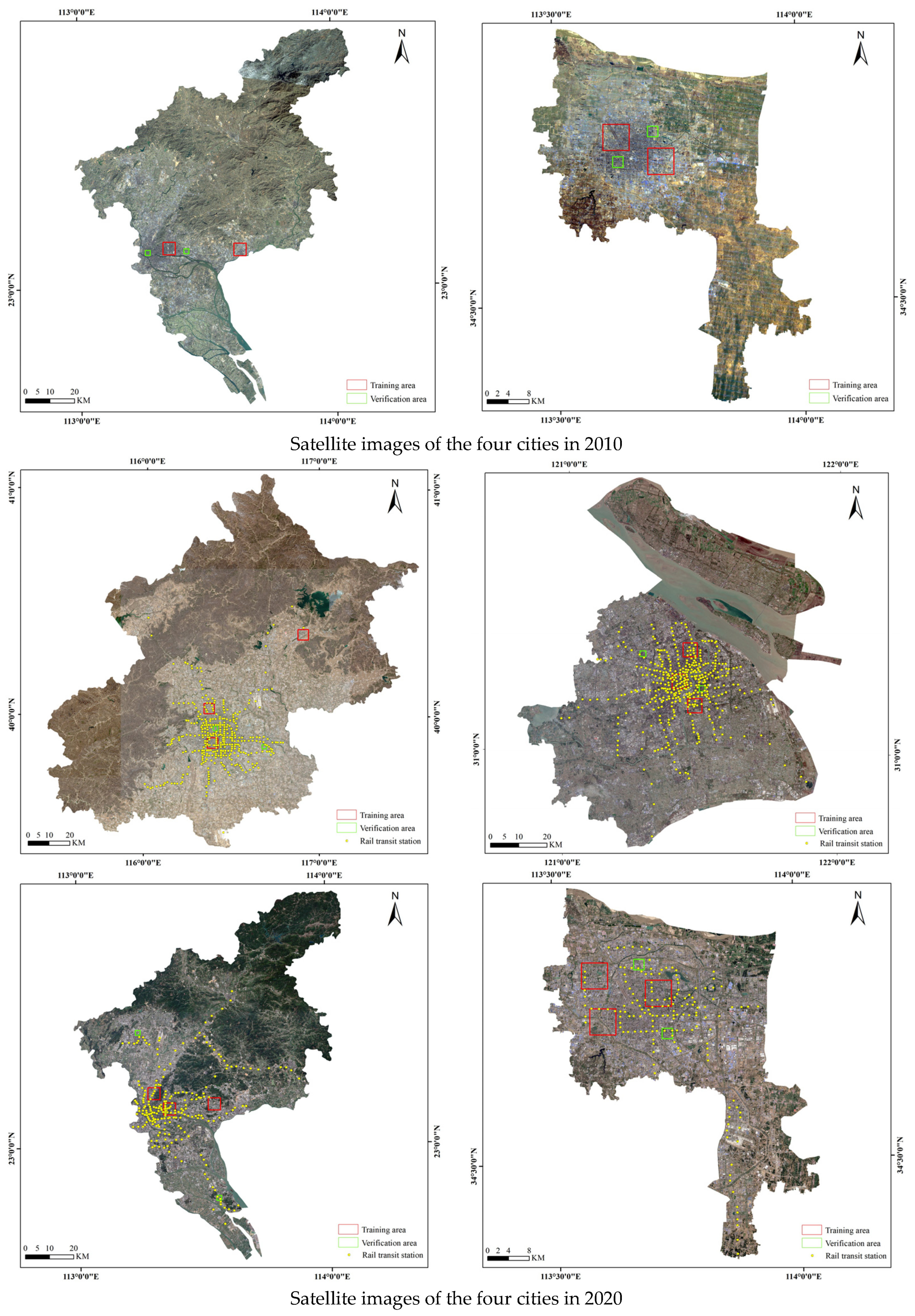
References
- Li, L.; Zhu, J.; Cheng, G.; Zhang, B. Detecting High-Rise Buildings from Sentinel-2 Data Based on Deep Learning Method. Remote Sens. 2021, 13, 4073. [Google Scholar] [CrossRef]
- Li, L.; Yan, Z.; Shen, Q.; Cheng, G.; Gao, L.; Zhang, B. Water body extraction from very high spatial resolution remote sensing data based on fully convolutional networks. Remote Sens. 2019, 11, 1162. [Google Scholar] [CrossRef]
- Bechtel, B.; Alexander, P.J.; Böhner, J.; Ching, J.; Conrad, O.; Feddema, J.; Mills, G.; See, L.; Stewart, I. Mapping Local Climate Zones for a Worldwide Database of the Form and Function of Cities. ISPRS Int. J. Geo-Inf. 2015, 4, 199–219. [Google Scholar] [CrossRef]
- Stewart, I.D.; Oke, T.R. Local climate zones for urban temperature studies. Bull. Am. Meteorol. Soc. 2012, 93, 1879–1900. [Google Scholar] [CrossRef]
- Xu, Y.; Chen, Y.; Zhou, K.; Guo, Y. The role of high-rise buildings in improving urban land use: A case study of Shanghai, China. Habitat Int. 2017, 60, 70–77. [Google Scholar]
- Chang, X.; Chen, R.; Wang, J.; Feng, Z.; Cao, S.J. Impacts of urban-scale building height diversity on urban climates: A case study of Nanjing, China. Energy Build. 2021, 251, 111350. [Google Scholar]
- Jia, S.; Wang, Y. Effect of heat mitigation strategies on thermal environment, thermal comfort, and walkability: A case study in Hong Kong. Build. Environ. 2021, 201, 107988. [Google Scholar] [CrossRef]
- Mislav, S.; Iztok, S.; Igor, G.; Vlatka, R. Seismic Design of Timber Buildings: Highlighted Challenges and Future Trends. Appl. Sci. 2020, 10, 1380. [Google Scholar]
- Mao, J.; Gao, N. The airborne transmission of infection between flats in high-rise residential buildings: A review. Build. Environ. 2015, 94, 516–531. [Google Scholar] [CrossRef] [PubMed]
- Miller, R.B.; Small, C. Cities from space: Potential applications of remote sensing in urban environmental research and policy. Environ. Sci. Policy 2003, 6, 129–137. [Google Scholar] [CrossRef]
- Gong, P.; Li, X.; Wang, J.; Bai, Y.; Chen, B.; Hu, T.; Liu, X.; Xu, B.; Yang, J.; Zhang, W.; et al. Annual maps of Global Artificial Impervious Area (GAIA) between 1985 and 2018. Remote Sens. Environ. 2020, 236, 111510. [Google Scholar] [CrossRef]
- Hong, T.; Kim, J.; Lee, M. A multi-objective optimization model for determining the building design and occupant behaviors based on energy, economic, and environmental performance. Energy 2019, 174, 823–834. [Google Scholar] [CrossRef]
- Zhao, J.; Du, Y. Multi-objective optimization design for windows and shading configuration considering energy consumption and thermal comfort: A case study for office building in different climatic regions of China. Sol. Energy 2020, 206, 997–1017. [Google Scholar] [CrossRef]
- Wu, C.; Yuan, Y.; Tang, Y.; Tian, B. Application of Terrestrial Laser Scanning (TLS) in the Architecture, Engineering and Construction (AEC) Industry. Sensors 2022, 22, 265. [Google Scholar] [CrossRef] [PubMed]
- Shao, Z.; Tang, P.; Wang, Z.; Saleem, N.; Yam, S.; Sommai, C. BRRNet: A Fully Convolutional Neural Network for Automatic Building Extraction From High-Resolution Remote Sensing Images. Remote Sens. 2020, 12, 1050. [Google Scholar] [CrossRef]
- Wang, Y.; Zorzi, S.; Bittner, K. Machine-Learned 3D Building Vectorization From Satellite Imagery. In Proceedings of the IEEE/CVF Conference on Computer Vision and Pattern Recognition (CVPR) Workshops, Virtual, 19–25 June 2021; pp. 1072–1081. [Google Scholar]
- Li, L.; Zhu, J.; Gao, L.; Cheng, G.; Zhang, B. Detecting and Analyzing the Increase of High-Rising Buildings to Monitor the Dynamic of the Xiong’an New Area. Sustainability 2020, 12, 4355. [Google Scholar] [CrossRef]
- Xu, X.; Li, W.; Ran, Q.; Du, Q.; Gao, L.; Zhang, B. Multisource remote sensing data classification based on convolutional neural network. IEEE Trans. Geosci. Remote Sens. 2018, 56, 937–949. [Google Scholar] [CrossRef]
- Li, Y.; Li, H.; Wu, X. Deep Learning-Based Classification of Hyperspectral Data. IEEE J. Sel. Top. Appl. Earth Obs. Remote Sens. 2014, 7, 2094–2107. [Google Scholar]
- Peng, C.; Li, Y.; Jiao, L.; Chen, Y.; Shang, R. Densely Based multi-scale and multi-modal fully convolutional networks for high-resolution remote-sensing image semantic segmentation. IEEE J. Sel. Top. Appl. Earth Obs. Remote Sens. 2019, 12, 2612–2626. [Google Scholar] [CrossRef]
- He, G.; Xing, S.; Xia, Z.; Huang, Q.; Fan, J. Panchromatic and multi-spectral image fusion for new satellites based on multi-channel deep model. Mach. Vis. Appl. 2018, 29, 933–946. [Google Scholar] [CrossRef]
- Qiu, C.; Schmitt, M.; Geiß, C.; Chen, T.K.; Zhu, X.X. A framework for large-scale mapping of human settlement extent from Sentinel-2 images via fully convolutional neural networks. ISPRS J. Photogramm. Remote Sens. 2020, 163, 152–170. [Google Scholar] [CrossRef] [PubMed]
- Krizhevsky, A.; Sutskever, I.; Hinton, G.E. ImageNet classification with deep convolutional neural networks. Commun. ACM 2017, 60, 84–90. [Google Scholar] [CrossRef]
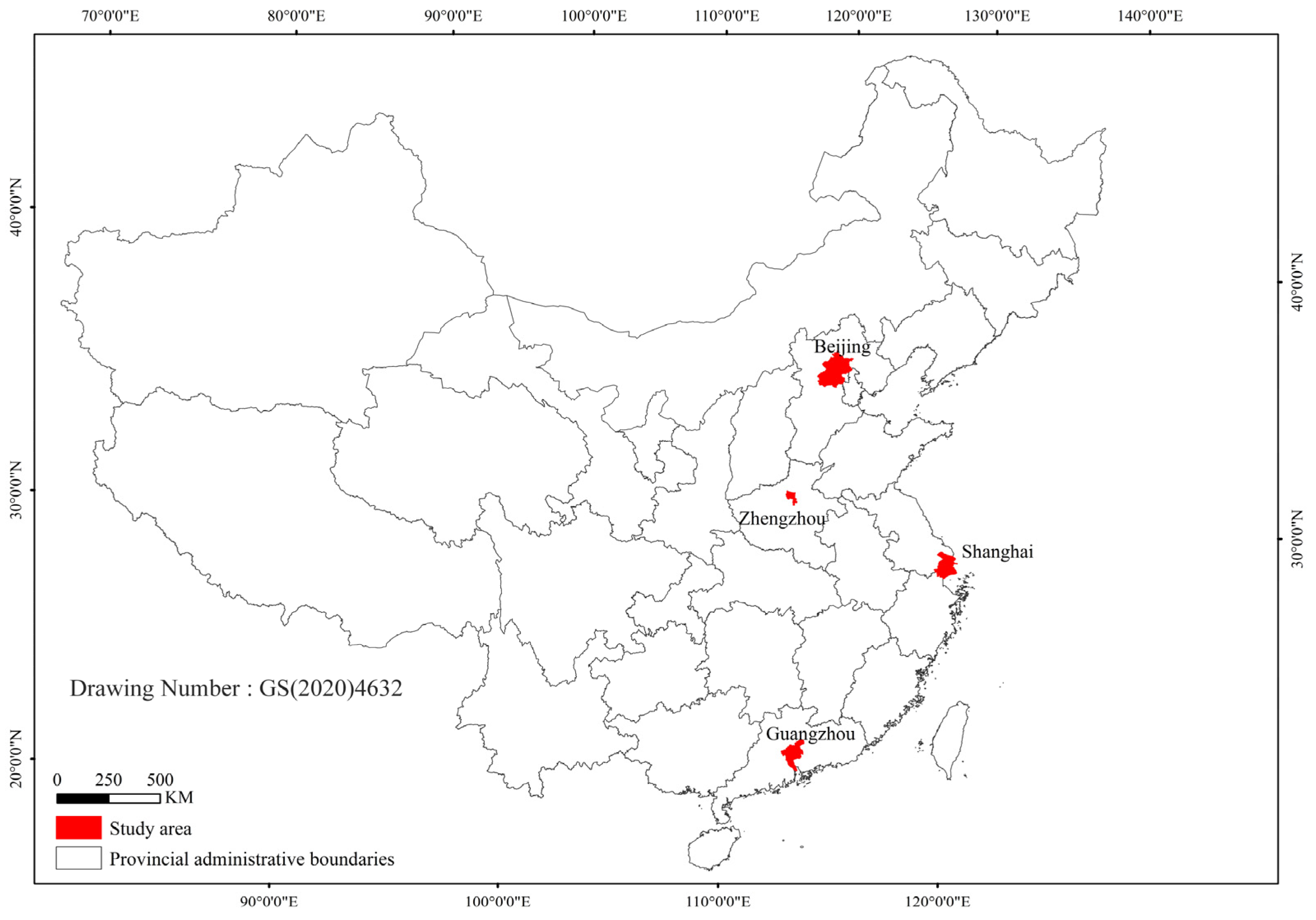




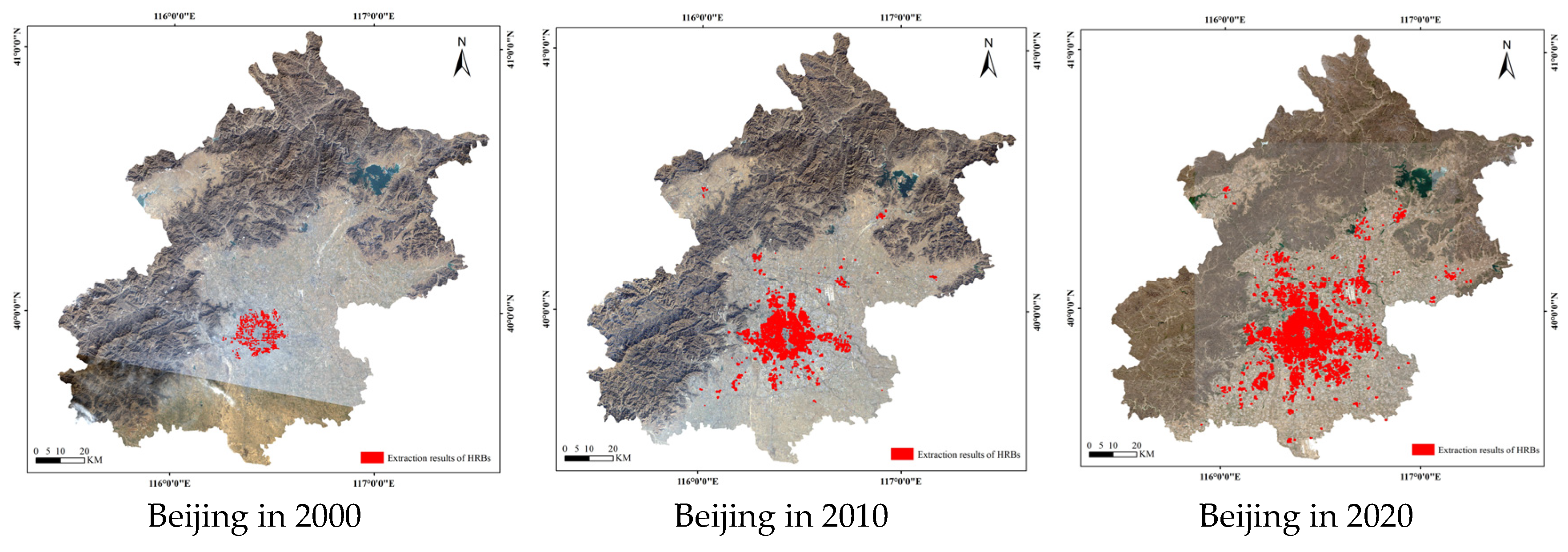
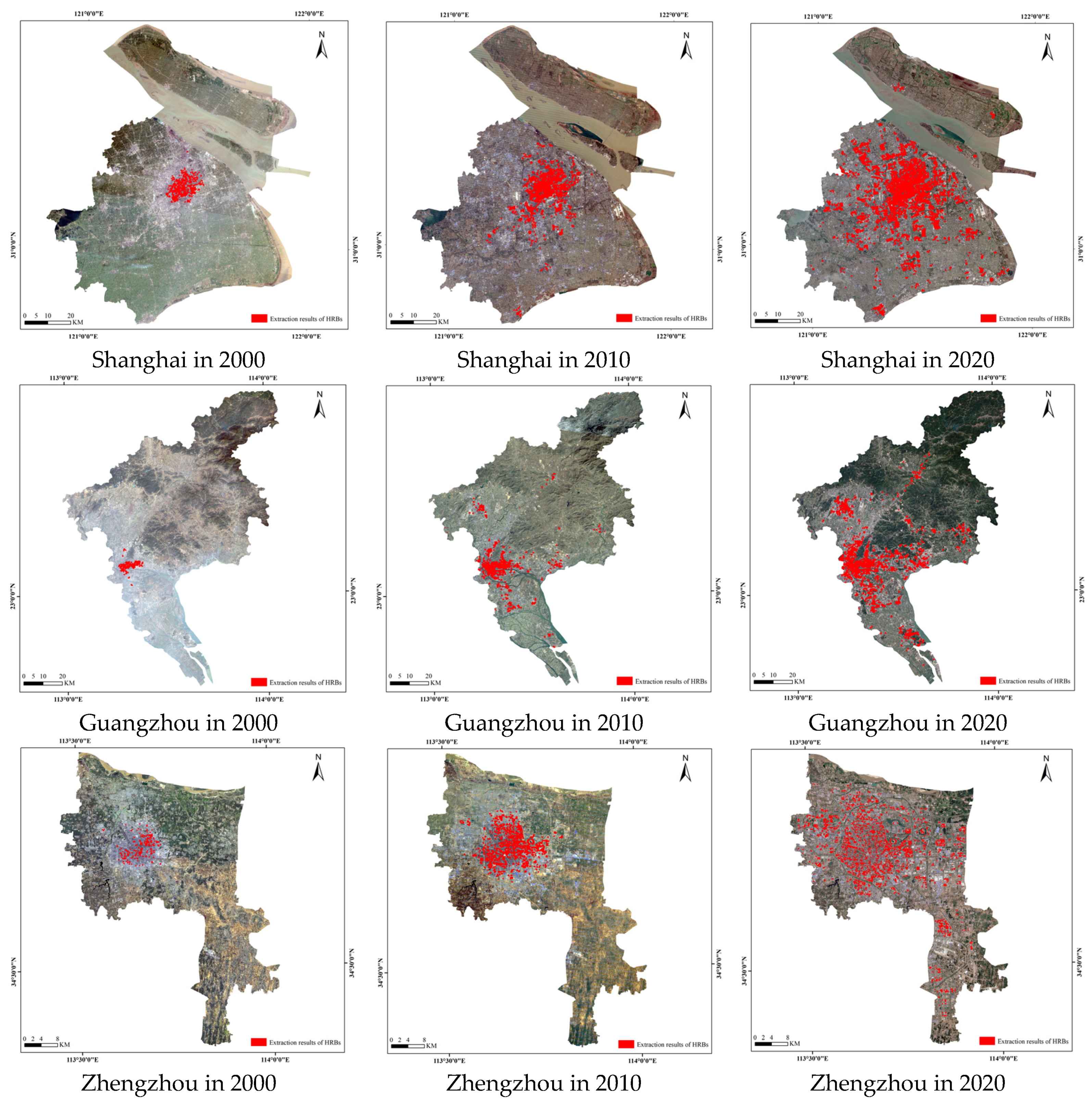

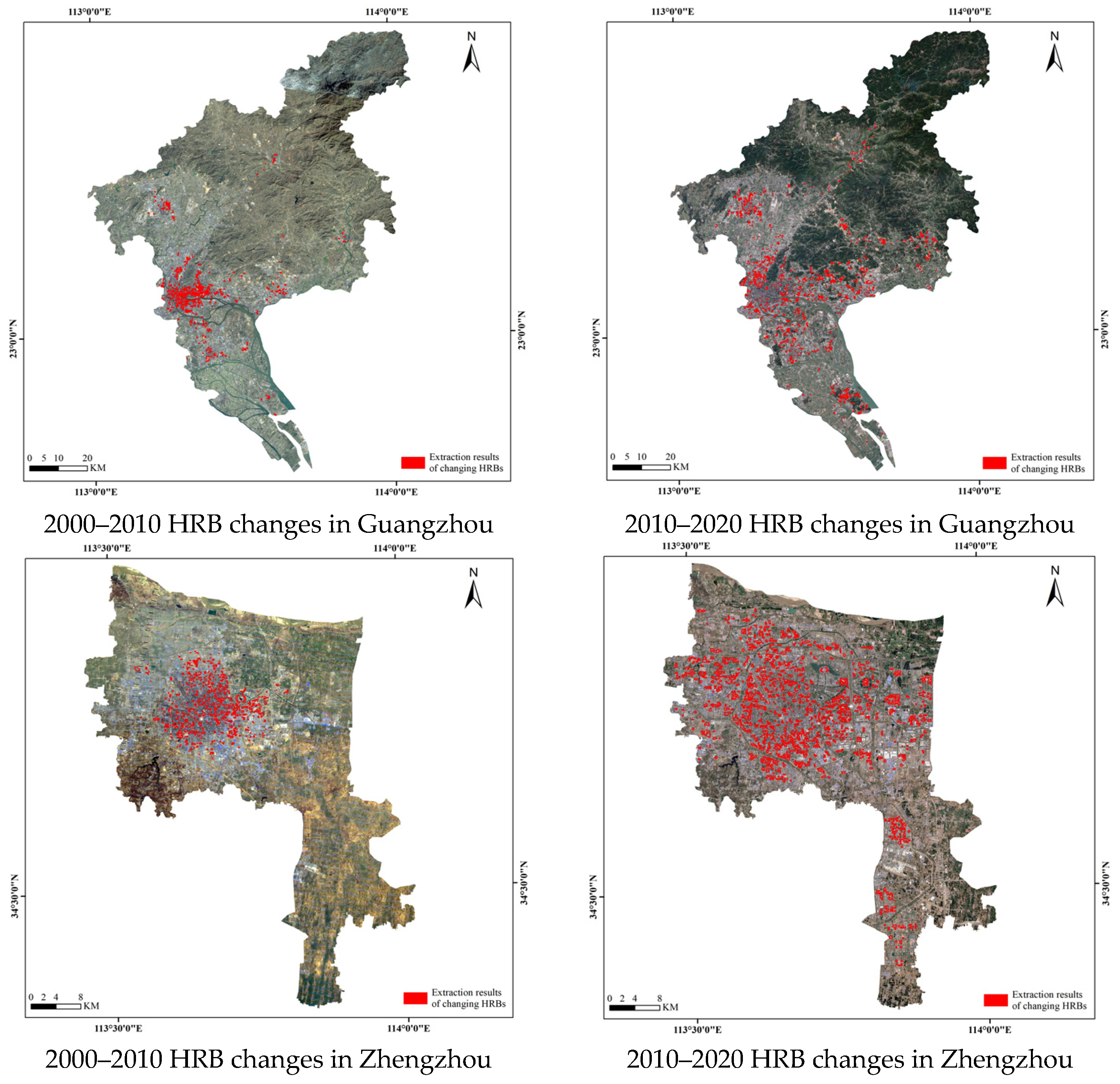
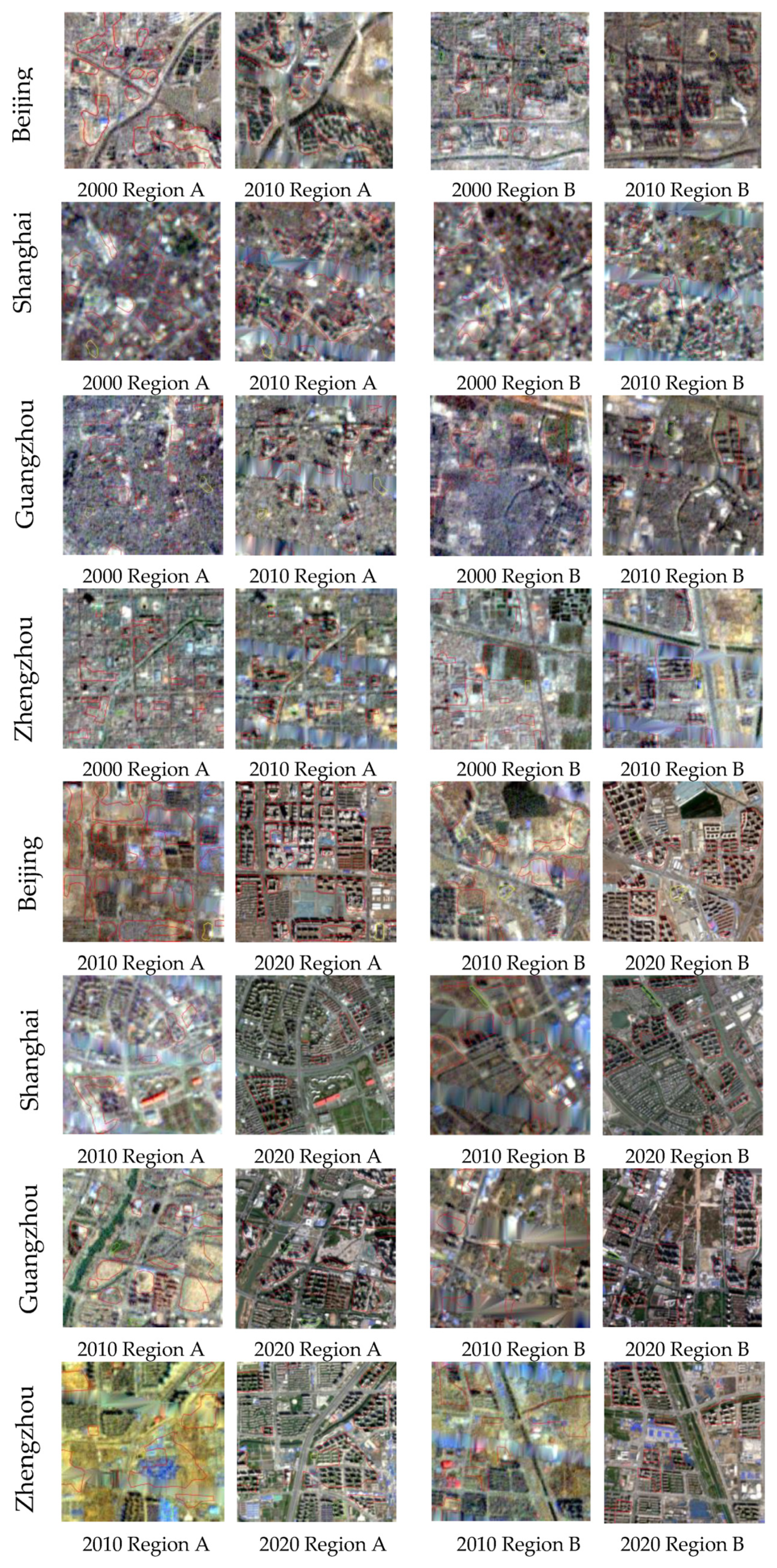
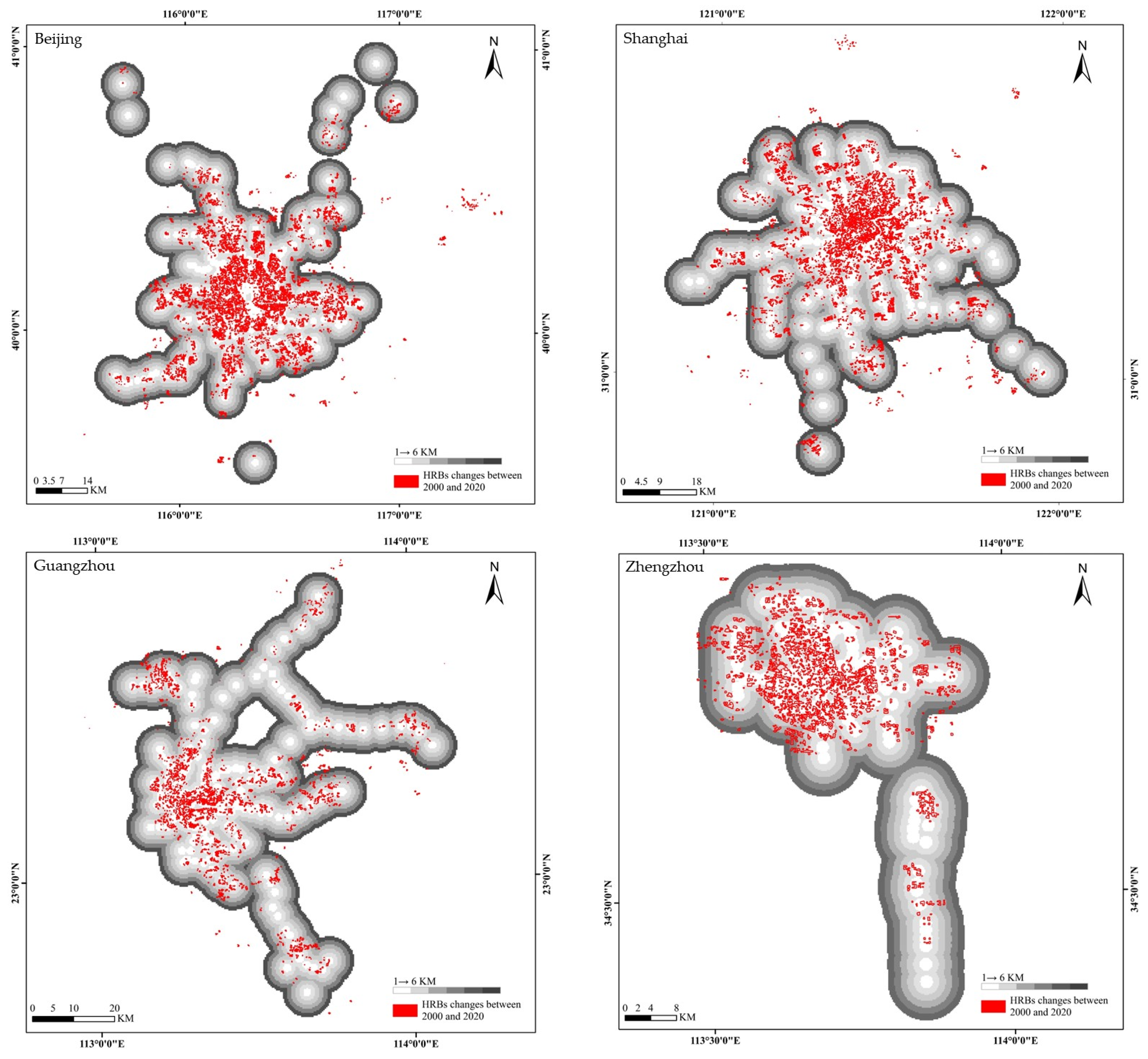
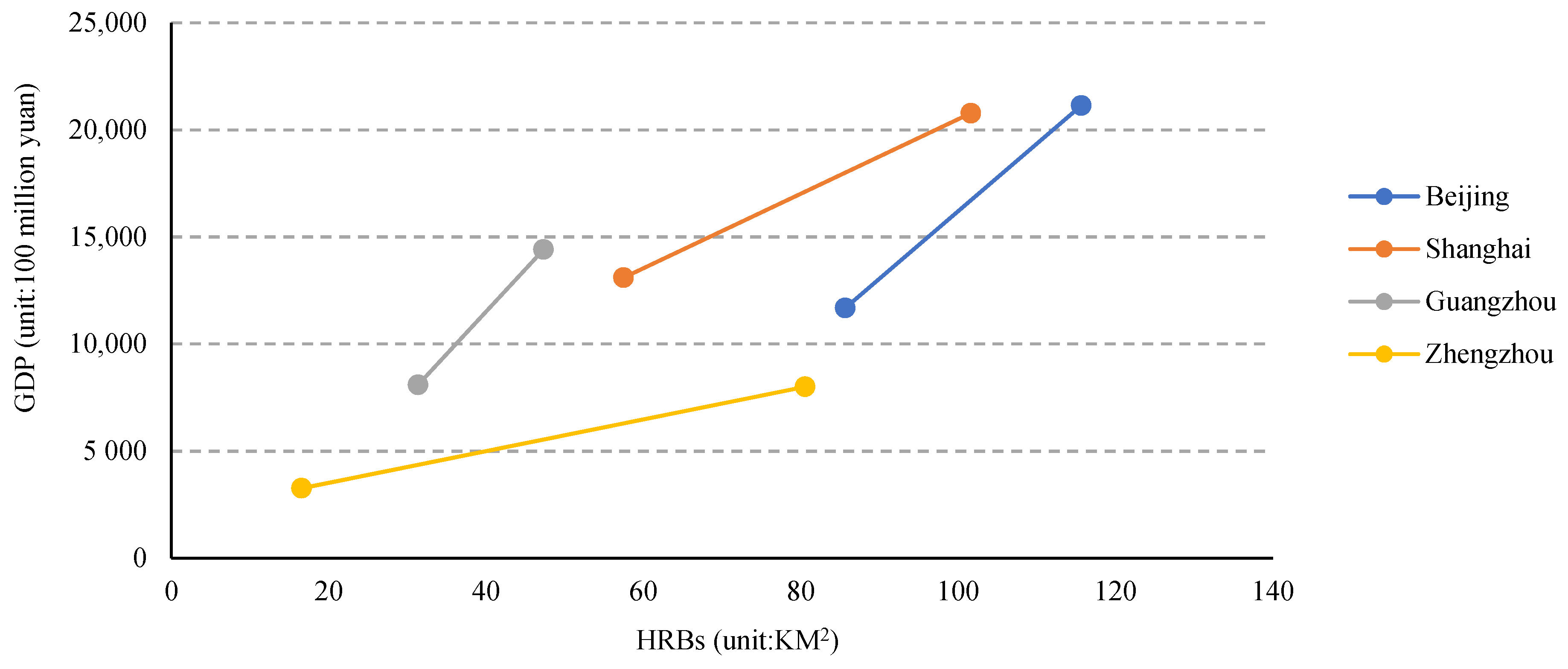
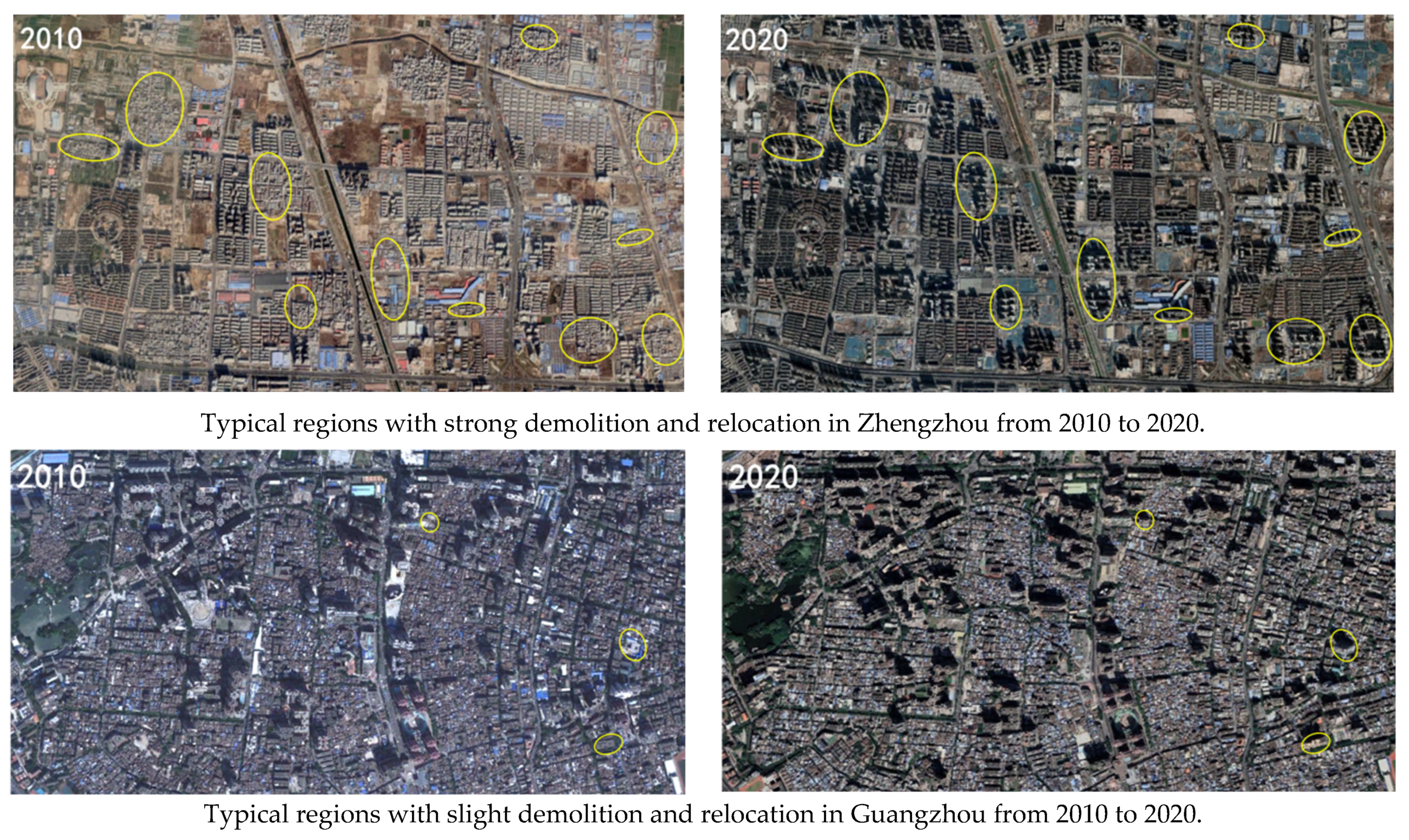
| City | Image Source Location | Acquisition Date |
|---|---|---|
| Beijing | S2-T50TNK | 10 May 2020 |
| S2-T50TNL | 10 May 2020 | |
| S2-T50TML | 13 May 2020 | |
| S2-T50TLK | 23 May 2020 | |
| S2-T50TLL | 23 May 2020 | |
| S2-T50TMK | 23 May 2020 | |
| S2-T50SLJ | 2 April 2020 | |
| S2-T50SMJ | 15 May 2020 | |
| L7-123032 | 19 December 2009 | |
| L7-123033 | 19 December 2009 | |
| L7-123032 | 24 December 1999 | |
| L7-123033 | 29 May 2020 | |
| Shanghai | S2-T51RUQ | 23 February 2020 |
| S2-T51SUR | 23 February 2020 | |
| S2-T51RTQ | 13 April 2020 | |
| S2-T51STR | 13 April 2020 | |
| L7-118038 | 17 January 2010 | |
| L7-118039 | 17 January 2010 | |
| L7-118038 | 26 February 2000 | |
| L7-118039 | 26 February 2000 | |
| Guangzhou | S2-T49QFF | 30 January 2020 |
| S2-T49QGF | 30 January 2020 | |
| S2-T49QGG | 30 January 2020 | |
| L7-122043 | 28 December 2009 | |
| L7-122044 | 31 December 2010 | |
| L7-122043 | 25 November 1999 | |
| L7-122044 | 2 January 2000 | |
| Zhengzhou | S2-T49SGU | 12 April 2020 |
| L333337-124036 | 26 May 2010 | |
| L7-124036 | 5 April 2000 |
| City | 2000 GDP | 2010 GDP | 2020 GDP |
|---|---|---|---|
| Beijing | 3277.80 | 14,964.00 | 36,102.60 |
| Shanghai | 4812.15 | 17,915.40 | 38,700.60 |
| Guangzhou | 2505.58 | 10,604.48 | 25,019.11 |
| Zhengzhou | 738.00 | 4000.00 | 12,003.00 |
| Accuracy of the Extracted HRBs in 2010 | |||||
| City | True Value | Overall Accuracy | False Rate | Average False Rate | Average Accuracy |
| Beijing | 25 | 92.00% (23) | 8.00% (2) | 4.19% | 91.88% |
| Shanghai | 38 | 92.11% (35) | 2.78% (1) | ||
| Guangzhou | 33 | 93.94% (31) | 3.13% (1) | ||
| Zhengzhou | 38 | 89.47% (34) | 2.86% (1) | ||
| Accuracy of the extracted HRBs in 2020 | |||||
| City | True Value | Overall Accuracy | False Rate | Average False Rate | Average Accuracy |
| Beijing | 50 | 94.12% (48) | 2.00% (1) | 3.02% | 92.89% |
| Shanghai | 27 | 92.86% (26) | 3.70% (1) | ||
| Guangzhou | 32 | 93.94% (31) | 3.13% (1) | ||
| Zhengzhou | 31 | 90.63% (29) | 3.23% (1) | ||
| The Accuracy of the Extracted HRBs changes from 2000 to 2010 | |||||
| City | True Value | Overall Accuracy | False Rate | Average False Rate | Average Accuracy |
| Beijing | 21 | 90.91% (20) | 4.76% (1) | 5.27% | 90.60% |
| Shanghai | 32 | 91.18% (31) | 6.06% (2) | ||
| Guangzhou | 29 | 90.32% (28) | 6.67% (2) | ||
| Zhengzhou | 29 | 90.00% (27) | 3.57% (1) | ||
| The accuracy of the extracted HRBs changes from 2010 to 2020 | |||||
| City | True Value | Overall Accuracy | False Rate | Average False Rate | Average Accuracy |
| Beijing | 27 | 89.66% (26) | 7.14% (2) | 3.18% | 91.17% |
| Shanghai | 21 | 95.24% (20) | (0) | ||
| Guangzhou | 31 | 90.32% (28) | (0) | ||
| Zhengzhou | 18 | 89.47% (17) | 5.56% (1) | ||
| Distance/City | Beijing | Shanghai | Guangzhou | Zhengzhou |
|---|---|---|---|---|
| 0–1 km | 54.7% | 54.0% | 51.6% | 48.7% |
| 1–2 km | 22.4% | 27.1% | 24.5% | 27.4% |
| 2–3 km | 9.3% | 7.7% | 9.5% | 11.9% |
| 3–4 km | 6.2% | 3.8% | 6.2% | 6.1% |
| 4–5 km | 2.8% | 2.4% | 2.5% | 3.2% |
| 5–6 km | 1.3% | 1.2% | 2.0% | 1.2% |
| ≥6 km | 3.8% | 3.8% | 3.3% | 1.5% |
Disclaimer/Publisher’s Note: The statements, opinions and data contained in all publications are solely those of the individual author(s) and contributor(s) and not of MDPI and/or the editor(s). MDPI and/or the editor(s) disclaim responsibility for any injury to people or property resulting from any ideas, methods, instructions or products referred to in the content. |
© 2023 by the authors. Licensee MDPI, Basel, Switzerland. This article is an open access article distributed under the terms and conditions of the Creative Commons Attribution (CC BY) license (https://creativecommons.org/licenses/by/4.0/).
Share and Cite
Yao, S.; Li, L.; Cheng, G.; Zhang, B. Analyzing Long-Term High-Rise Building Areas Changes Using Deep Learning and Multisource Satellite Images. Remote Sens. 2023, 15, 2427. https://doi.org/10.3390/rs15092427
Yao S, Li L, Cheng G, Zhang B. Analyzing Long-Term High-Rise Building Areas Changes Using Deep Learning and Multisource Satellite Images. Remote Sensing. 2023; 15(9):2427. https://doi.org/10.3390/rs15092427
Chicago/Turabian StyleYao, Shun, Liwei Li, Gang Cheng, and Bing Zhang. 2023. "Analyzing Long-Term High-Rise Building Areas Changes Using Deep Learning and Multisource Satellite Images" Remote Sensing 15, no. 9: 2427. https://doi.org/10.3390/rs15092427
APA StyleYao, S., Li, L., Cheng, G., & Zhang, B. (2023). Analyzing Long-Term High-Rise Building Areas Changes Using Deep Learning and Multisource Satellite Images. Remote Sensing, 15(9), 2427. https://doi.org/10.3390/rs15092427






